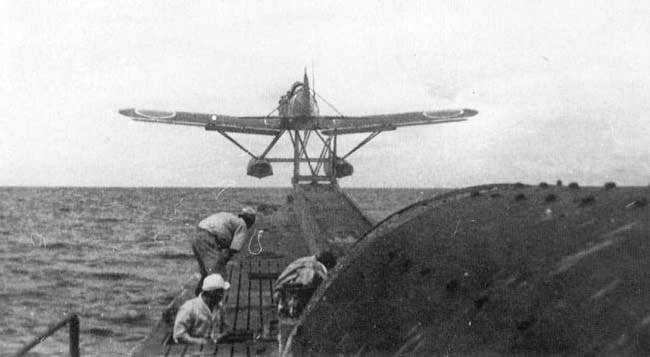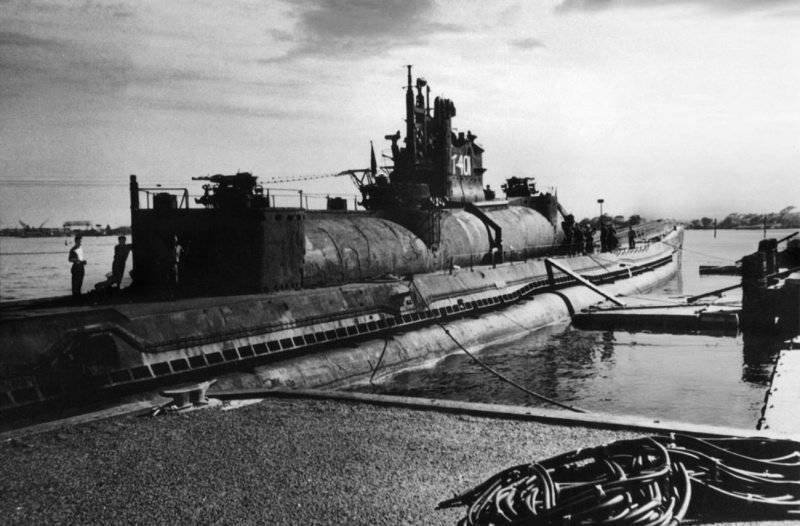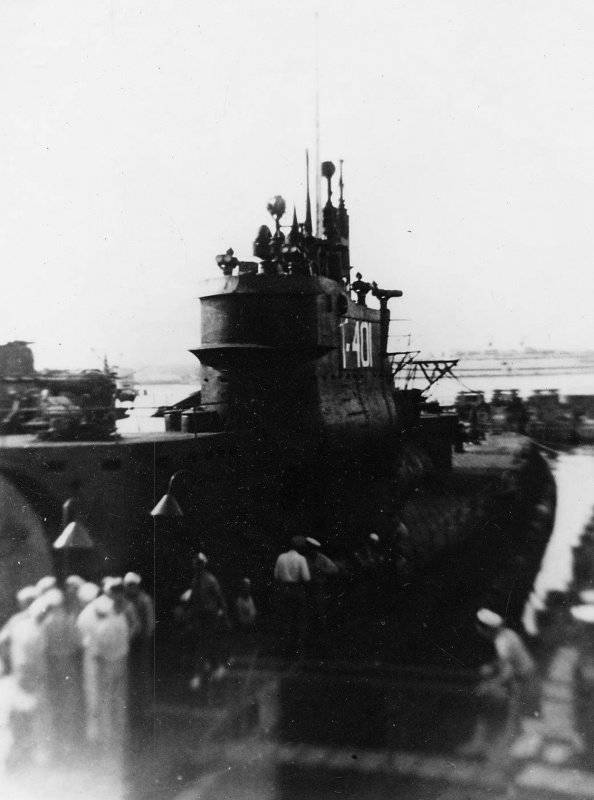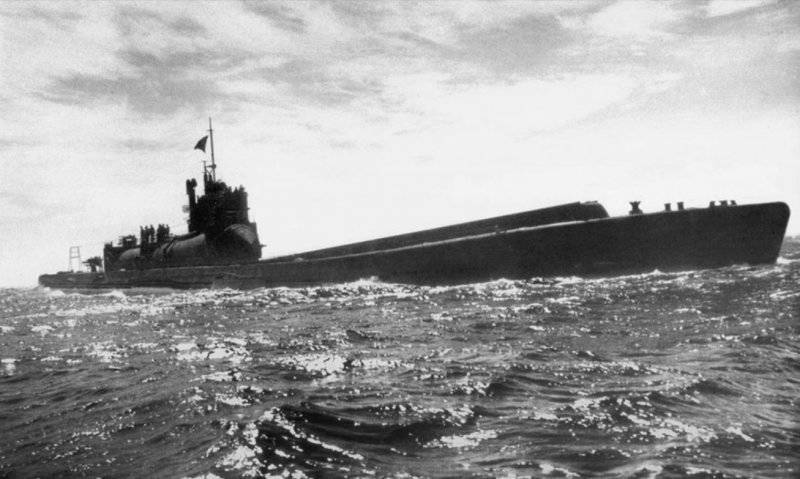Submarine aircraft carriers of the Japanese Empire
Of all the projects of submarine aircraft carriers created between the world wars, the work of Japanese designers deserves special attention. At a certain point, the military leadership of the Land of the Rising Sun offered to make the plane not only with the eyes of a submarine, but also with its long arm with a sword. Indeed, the carrying capacity of even purely reconnaissance light aircraft made it possible to take a couple of small bombs on board. It is quite clear that for full bombing this will not be enough, but sometimes two or three bombs are enough. True, the effect of such an attack would rather be psychological.
The first Japanese submarine with the ability to transport aircraft was built in 1932 year. Boat I-2 project J-1M had a sealed hangar for transporting aircraft. Hangar dimensions allowed to keep it light reconnaissance Caspar U-1 - German 20-s aircraft, produced in Japan under license. Only one instance of the J-1M submarine was built. Despite the preparations for the coming expansion, which were in full swing, the Japanese were in no hurry to build an underwater carrier fleet. The submarine I-2 was equally military and test: the construction of an aircraft carrier submarine associated with many specific problems. For example, it is much easier to seal a small manhole for the crew than to prevent water from entering through the slots in the large manhole of the hangar. In addition, it was necessary to create a compact and load-lifting crane: in the J-1M project there was no take-off springboard, so the plane had to take off and land from the water. For transfer to the surface of the water and lifting onto the boat, the latter had to have a crane. At first, with a crane, we had to suffer - salty sea water had a very bad effect on its mechanisms and at times the parts were wedged. However, the crane and the design of the hangar eventually brought to mind. The fundamental possibility of creating a submarine aircraft carrier, carrying strike aircraft, has been proven.
By 1935, the fleet of submarine aircraft carriers in Japan has replenished with another boat. This was the J-6 I-2 project. From its predecessor, it is distinguished by a number of design changes. It was slightly larger, had better running characteristics, and in a larger hangar, one reconnaissance aircraft such as Watanabe E9W could be transported. Although he made the first flight simultaneously with the launch of the boat on the water, then it was E9W that later became the basis of the I-6 aircraft armament. Thanks to a reasonable approach to testing the previous submarine aircraft carrier, Japanese engineers managed to create a more advanced design and did not repeat a number of errors. However, the plane still took off from the water. If landing on the floats did not cause any complaints to anyone - it is not difficult to imagine the size of a submarine equipped with a full-fledged flight deck - then the need to launch the plane first, after which it could take off, was the cause of complaints. In particular, this fact was the reason that the project J-2 was able to "generate" only one submarine-aircraft carrier.

The next project of the Japanese submarine aircraft carriers was the J-3. It was a more serious submarine: the hangar already contained two aircraft, and for their takeoff there were a springboard and a catapult. In 1939, the first boat of the series, I-7, was launched. A little later, I-8 was also completed. Aviation the armament of these two submarines were Yokosuka E14Y aircraft. These seaplanes were much better than the previous ones, although by their characteristics they still could not compete with other Japanese bombers. And the payload of four 76-kilogram bombs was clearly insufficient. However, as an armed scout for submarines, the E14Y was pretty good.
A few months before the attack on Pearl Harbor in the Japanese naval system fleet boat I-9 entered. She became the lead submarine of the A1 project. Subsequently, two similar submarines were built, which received the designations I-10 and I-11. With a solid displacement of about 4000 tons and six torpedo tubes, these boats also had on board one Yokosuka E14Y aircraft and a stock of various weapons for them. It is noteworthy that the A1 was the first Japanese project of an underwater aircraft carrier, which did not have any operational restrictions associated with the design of the hatch of the hangar. The designers successfully coped with the problem of sealing it, and Project A1 could safely walk at depths of up to 100 meters without the risk of flooding the room for the aircraft. At the same time, the outer contours almost did not spoil the streamlining of the submarine and did not "eat" speed and range. The lead boat of the project, which bore the designation I-9, namely its plane, on December 7, 1941, made a photo and filming of the results of the attack on the American naval base Pearl Harbor.
The A1 project to some extent became the basis for the subsequent series of Japanese submarine aircraft carriers. So, in a matter of months, the following projects were designed and put into a series of boats:
- A2. In fact, it was an upgrade of A1 with the addition of a number of new systems. The equipment associated with the aircraft has not undergone any changes. Built one boat;
- AM. Deep upgrade A1. The length of the hull was reduced, which, however, did not prevent the increase of the hangar to accommodate the second E14Y aircraft. The boats of this project I-13 and I-14 were ready only for 44-th year.
Developments on the projects of the “J” and “A” families allowed us to gather all the necessary experience and already in the summer of 42, an even more sophisticated I-15 submarine from the B1 project was launched. Before 44, 20 of such submarines with symbols from I-15 to I-39 will be built. It was the submarine of the B1 project that became one of the first Japanese submarine-aircraft carriers that had a chance to take part in striking the United States. 9 September 1942, the crew of the Yokosuka E14Y aircraft, composed of pilot N. Fujita and arrow S. Okuda dropped several incendiary bombs on a forest in Oregon. Shortly before the operation, later called “Lookout Air Raid”, rain and high humidity of foliage, soil, etc. took place in that area. did not let incendiary bombs do their work. The only strike of the aircraft carrier boat to the continental United States was unsuccessful.

The B1 project, like the previous A1, became the basis for the whole family. Thus, several of its upgrades were carried out: B2, B3 and B4. From each other, they differed in technical features and the number of manufactured boats. After twenty submarines of the B1 variant, only six B2 submarines and three B3 / 4 submarines were made. The construction of eight B2 and twelve B3 / 4 was canceled. By the end of 43, when this decision was made, Japan needed other weapons for its fleet.
However, the reduction in construction did not affect the overall plans of the Japanese command. Back in 1942, the design of a new type of submarine aircraft carrier, designated I-400, was started. Submarines with a submerged displacement of more than 6500 tons and a length of about 120 meters should have a submarine range of 110 kilometers and a surface more than 60 thousand kilometers. In doing so, they had to carry 20 torpedoes and 3-4 aircraft. Especially for boats I-400 developed aircraft Aichi M6A Seiran. This aircraft could already carry serious weapons in the form of two 250-kilogram or one 800 kg caliber bomb. In addition, the possibility of using special containers with rodent vectors of diseases was seriously considered. Only one discharge of such a container on the continental territory of the United States could lead to serious consequences. And the range of the submarine allowed to go beyond the Pacific.
The photo depicts the head submarine of the I-400 series on the day after it was handed over to the Americans. Japanese submarines of the I-400 series were the largest submarines before the appearance of atomic submarines. Their design was launched by Admiral Yamamoto, who needed an underwater aircraft carrier capable of carrying seaplanes armed with 800-kg bomb or a pilot. This aircraft was the Aichi M6A "Seiran" (Mountain Haze), which, by the way, did not receive a nickname from the allies, among the few late Japanese cars. Of the 18 boats planned for construction, the entire 3 was completed, but they also did not take part in the hostilities.
The head boat of the I-400 project was laid in February of the 43. The fleet wanted to get 18 such submarines. However, just a few months after laying the first submarine of the series, the plans had to be cut in half. The constant deterioration of the situation on the fronts led to the fact that until the end of the war of the planned six submarines, the Japanese managed to lay only six. As for the completion of construction, four boats were launched, and only three were put into operation. Of particular interest is the design of these boats. The hull lines were non-standard for such equipment of Japanese and foreign production. So, to ensure the required internal volume and preserve acceptable dimensions in the bow, the hull of the boat had an 8-shaped section. To the central part, the section smoothly turned into a semblance of the “∞” sign, and the feed again looked like a figure eight. Such a profile of a double-hull boat was due to the fact that the technical task required a large amount of fuel on board, and a separate hangar led to an increase in the vertical dimensions of the structure. Therefore, a tubular sealed hangar with a diameter of about 3,5 meter was placed in the middle of the boat, under the wheelhouse. Due to the shape of the middle part of the hull, it did not lead to a significant increase in the height of the boat. In a ready for use form on the boat could be three M6A aircraft. Before the submarine took off, the sailors opened the hangar doors, installed the aircraft on a catapult (on the bow of the boat), laid out its plane and the pilot took off. The plane landed on water, from where it was raised by a crane. In addition to the three airplanes ready for departure, a fourth could be transported in a disassembled form, but the volume of the room was only enough for three assembled ones.

Due to persistent problems with resources, the head boat of the I-400 project was commissioned by the Japanese Navy only on December 30 of the year 1944. The 8 of January of the next 45 was followed by the I-401 of the same project, and the third I-402 became a warship only at the end of July. Of course, these submarines did not have time to do something to change the situation at the front. In August, the month of 45, a few days before the end of the Second World War, the crews of the boats decided to surrender to the Americans. Boats I-400 and I-401 for a few months of their combat work did not have time to war up properly. So, first they received an order to attack the locks of the Panama Canal. However, the leadership of the fleet soon realized the futility of such an operation and canceled its order. Now, submarine aircraft carriers had to go to the atoll of the Uliti and attack the American ships stationed there. On August 6, the boats went out to sea, but after a couple of days they returned - a fire occurred on I-400 and repair was necessary. I-401, in turn, could not cope with the task on their own. Repeated exit was first planned on the 17-th number. Then the beginning of the operation was transferred to August 25, but in the end the 20 of the boat commanders received an order to destroy all offensive weapons. Execution of this order meant only one thing - aircraft carrier boats could no longer do anything to save Japan from defeat. The crew of I-400 shot the torpedoes into the sea and dropped the planes into the water. The captain of the boat I-401 Aridzumi, giving the order to do the same, shot himself.

History Japanese submarine aircraft carriers ended in the spring of 1946. After putting the I-400 boats to the Americans, they were taken to Pearl Harbor, where they were carefully studied. In March, 46, the Soviet Union, in accordance with the available agreements, demanded that the United States provide access to Japanese miracle weapons. Not wanting to share trophies, the US command issued an order to destroy them. On April 1, not far from Pearl Harbor, I-402 was shot by torpedoes, and on May 31 I-400 and I-401 set off to the bottom.
Information sources:
http://korabley.net/
http://voenhronika.ru/
The Maritime Collection and Technology Youth Magazines
In the spring of 1946, after 8 months after the end of World War II, the decision was made at the highest government level in the United States: one of the most advanced systems of Japanese weapons was sent to the seabed to avoid its falling into the hands of the Soviet Union. We will learn how the course of the Second World War could have changed if the Japanese had carried out their project ...
How could change the course of the Second World War, if the Japanese had carried out their project to create a giant submarine aircraft carrier.

Information